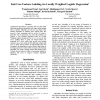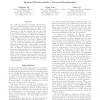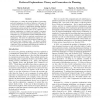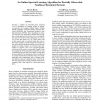116
click to vote
AAAI
2011
14 years 1 months ago
2011
Applications that adapt to a particular end user often make inaccurate predictions during the early stages when training data is limited. Although an end user can improve the lear...
129
Voted
AAAI
2011
14 years 1 months ago
2011
We consider the problem of modeling network interactions and identifying latent groups of network nodes. This problem is challenging due to the facts i) that the network nodes are...
142
Voted
AAAI
2011
14 years 1 months ago
2011
Coarse-to-fine approaches use sequences of increasingly fine approximations to control the complexity of inference and learning. These techniques are often used in NLP and visio...
114
click to vote
AAAI
2011
14 years 1 months ago
2011
In this paper, we propose a variant of the conservativeupdate Count-Min sketch to further reduce the overestimation error incurred. Inspired by ideas from lossy counting, we divid...
132
click to vote
AAAI
2011
14 years 1 months ago
2011
We present a dual decomposition approach to the treereweighted belief propagation objective. Each tree in the tree-reweighted bound yields one subproblem, which can be solved with...
AAAI
2011
14 years 1 months ago
2011
AAAI
2011
14 years 1 months ago
2011
Recently the general Game Description Language (GDL) has been extended so as to cover arbitrary games with incomplete/imperfect information. Learning—without human intervention�...
125
click to vote
AAAI
2011
14 years 1 months ago
2011
In this paper we examine the general problem of generating preferred explanations for observed behavior with respect to a model of the behavior of a dynamical system. This problem...
AAAI
2011
14 years 1 months ago
2011
We propose a fast batch learning method for linearchain Conditional Random Fields (CRFs) based on Newton-CG methods. Newton-CG methods are a variant of Newton method for high-dime...
159
click to vote
AAAI
2011
14 years 1 months ago
2011
Recently, a number of researchers have proposed spectral algorithms for learning models of dynamical systems—for example, Hidden Markov Models (HMMs), Partially Observable Marko...




